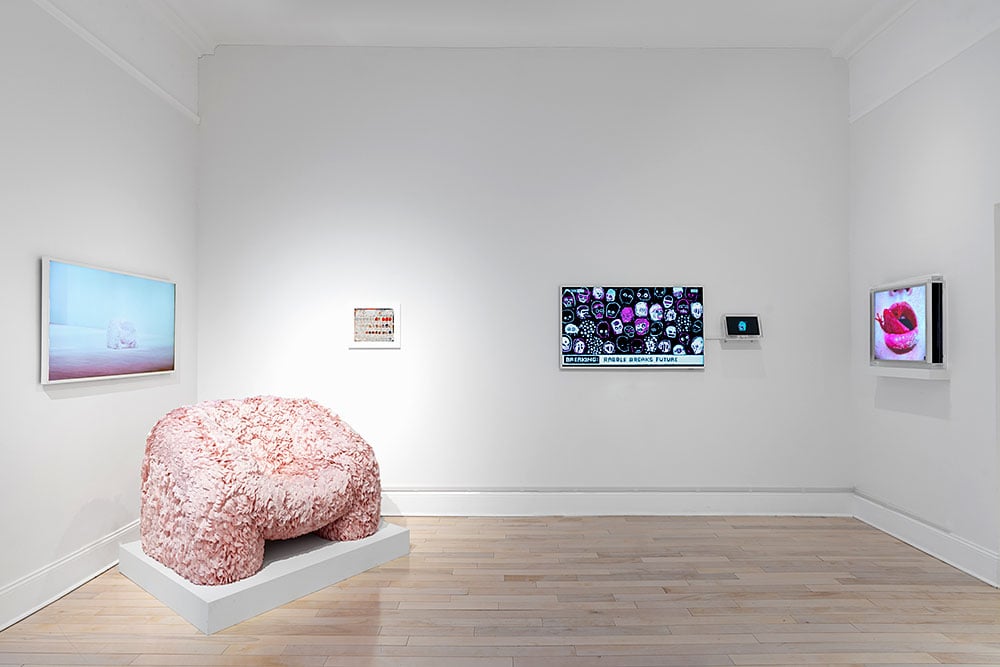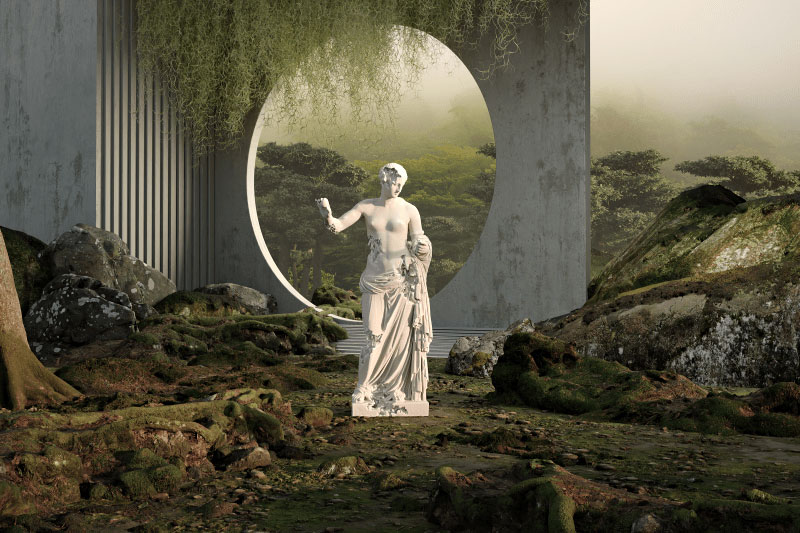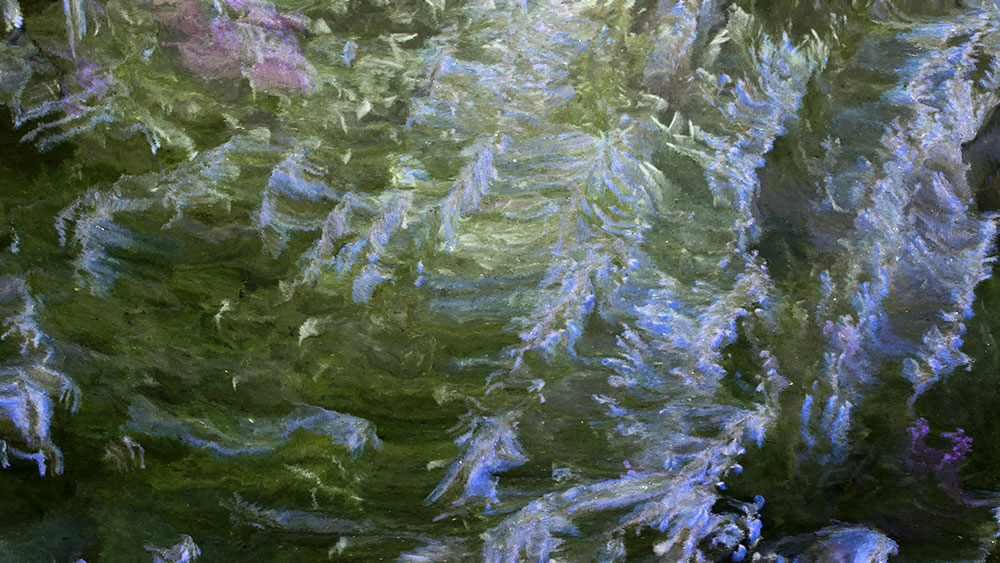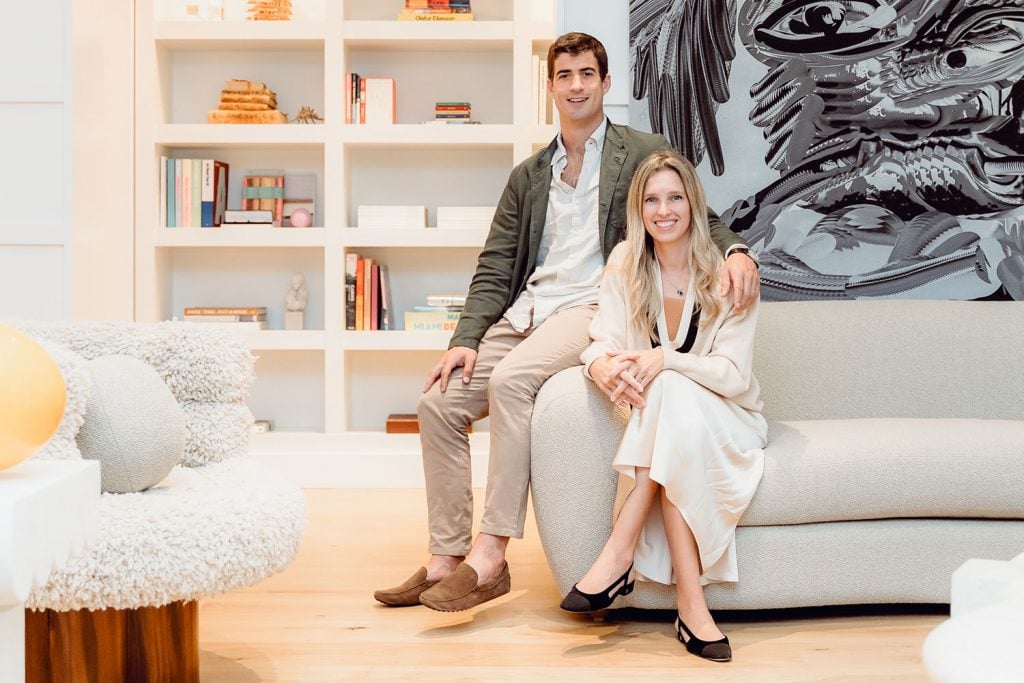Digital art collectors Pablo Rodríguez-Fraile and Desiree Casoni are on a mission. In 2011, having launched their eponymous RF.C Art collection, one of the largest collections of cross-disciplinary digital art in the world, they needed a way to showcase their tokenized acquisitions. Why should the digital trailblazers they collected—Refik Anadol, Beeple, Pak, Kjetil Golid, Davide Quayola, and Andrés Reisinger—be confined to computer screens and devices?
On view through March 14, the exhibition “Beyond Digital” at Venus Over Manhattan highlights the RF.C Art collection while bridging the digital and physical realms in a gallery setting. But rather than suggest the dominance of one realm over the other, artists in the show—including the above names, as well as Dmitri Cherniak, Trevor Jones, Helena Sarin, Slime Sunday, and XCOPY—advocate for an interaction between the two.

Installation view of “Beyond Digital” at Venus Over Manhattan. Courtesy of Venus Over Manhattan.
“Beyond Digital” marks the first time a single collection of digital art has been showcased in a contemporary art space, according to the gallery. Despite the current “crypto winter,” Pablo Rodríguez-Fraile and Desiree Casoni hope to show that digital pieces can exist in real-life, physical spaces. That the RF.C Art collection now numbers at least 2,000 suggests that collectors can indeed display and live with their digital works.
The couple has been thinking about digital art’s place among traditional mediums since they met in New York City while students at Columbia University in the aughts. They bonded over their mutual idealism concerning art and technology, and became early adopters of the NFT marketplace and the paradigm shift it afforded.
It wasn’t long before they moved to Miami to start a family and delve into South Florida’s thriving art scene. Casoni brought her experience as an architect and interior designer, while Rodríguez-Fraile came with his training as a mathematician and economist, specializing in blockchain technology (readers may recall his sale of a Beeple token for $6.6 million; he was, in fact, the first collector of Beeple). He’s also a co-founder of Aorist, a platform focused on climate-friendly digital art commissions, and an early investor in Decentraland.
We caught up with Rodríguez-Fraile for a glimpse into the couple’s ever-evolving digital art collection.
What was your first purchase (and how much did you pay for it)?
My first art purchase was a gift to my wife when we first started dating. It was a Spanish artist called Guillermo Mora and we still have it today.
Incredibly, I do not remember exactly my first digital art purchase as in the early times I was experimenting with other digital assets when I stumbled across digital art. What I vividly remember, however, was the first time it really sparked our interest; that was when I learned about Pak. It completely drew me down the rabbit hole. I paid a few thousand dollars for my first acquisition of Pak.

Andrés Reisinger, Winter Sofa. Courtesy of Pablo Rodríguez-Fraile and Desiree Casoni.
What was your most recent purchase?
My most recent acquisition is a commission of a digitally native work connected to the physical realm through a yet-to-be produced design piece. It is called Winter Sofa by Andrés Reisinger. It has a digital counterpart yet the work is only complete together with the physical sofa. It is a unique work that looks at the relationship between the traditional and the new, the analog versus the digital.
Which works or artists are you hoping to add to your collection this year?
I have developed a semi-obsession with Sofia Crespo and her studio Entangled Others. Her work is extraordinarily relevant to the times, of the utmost quality, and well-executed. In addition, she has a personality and human virtues that will be very beneficial to her over the long term. I think she is going to be very relevant.

Beeple, CRYPTO IS BULLSHIT. Courtesy of Pablo Rodríguez-Fraile and Desiree Casoni.
What is the most expensive work of art that you own?
I do not look at the collection in terms of monetary value. However, I am blessed that I have been supporting this beautiful creative ecosystem in a very active manner since the early days. Throughout this time, we have been able to acquire some works that form part of digital art history and that are literally priceless. I do not envision ever parting with the collection other than as a donation to a major institution.

Pak, Fade. Courtesy of Pablo Rodríguez-Fraile and Desiree Casoni.
Some of the highlights might include Refik Anadol’s first tokenized Machine Hallucinations, or the only single-edition of Generative Study 1 in a private collection (from MoMA’s “Unsupervised”), or Beeple’s first ever single-edition release CRYPTO IS BULLSHIT, or Pak’s Fade, Red, or The Cube.

Pak, The Cube. Courtesy of Pablo Rodríguez-Fraile and Desiree Casoni.
Another highlight is Daniel Arsham’s time-based work Eroding and Reforming Venus of Arles, which changes over time (taking 72.6 years to reach the final state—the average lifespan of a human on earth today) and is the only single-edition digital work by Daniel.

Daniel Arsham, Eroding and Reforming Venus of Arles (72.6 Years). Courtesy of Pablo Rodríguez-Fraile and Desiree Casoni.
Where do you buy art most frequently?
Everywhere! Whether it is directly from the artist, or the gallery/group representing them. However we rarely ever acquire just one work; we like to comprehensively support artists throughout their long-term careers, and over time the method of release varies. I do collect in Aorist, of course, as well as other platforms in the digital realm such as TRLab. On the more analog side, even as they are heavily embedded in the digital ecosystem, I like and trust Adam Lindemann and Venus Over Manhattan.
Is there a work you regret purchasing?
Rather than regret, there are some works that if we had to go back and acquire again, we would not do so with the information that we have today. However, we see each step of the journey as a learning opportunity and as a way to further define what we really connect and engage with.
What we can share, however, is that even though we have only sold a handful of works from the RF.C collection, what we ended up regretting is letting go of them. This sentiment, however, is counterbalanced by knowing that they both help the artists and their paths—and we found great new collectors and stewards of these works.
What work do you have hanging above your sofa? What about in your bathroom?
Above the sofa we have a work by Davide Quayola from the series “Jardins d’Été.” Quayola is a personal favorite of ours and in our opinion, one of the most sophisticated artists in the contemporary digital world. For the bathroom, we commissioned local artist Gabriela Benatar for a nature-based mural.

Davide Quayola, from the series “Jardins d’Été.” Courtesy of Pablo Rodríguez-Fraile and Desiree Casoni.
What is the most impractical work of art you own?
We don’t seem to have any impractical pieces for us personally, but we do have some far-fetched ones like Pak’s [single] pixels.
What work do you wish you had bought when you had the chance?
Further works by Refik Anadol and perhaps more generative works.
If you could steal one work of art without getting caught, what would it be?
I wouldn’t do that, yet at some point I wish to add a work by Mark Rothko to the collection.
More Trending Stories:
A Wall Street Billionaire Shot Himself in His Family Office. His Death Is Reverberating in the Museum World, and the Art Market
Researchers in Vietnam Discovered That Two Deer Antlers Languishing in Museum Storage Are Actually 2,000-Year-Old Musical Instruments
‘That Little Piece of Energy Is Magnified’: Artist Wangechi Mutu on Honoring the Spirit of the Natural World in Her Fantastical Works
We Asked ChatGPT About Art Theory. It Led Us Down a Rabbit Hole So Perplexing We Had to Ask Hal Foster for a Reality Check
‘Innovation Is Not Repetition’: Living Legend Gaetano Pesce on His Boundary-Pushing Furniture Design and ‘Mass-Produced Originals’
Hit Mockumentary ‘Cunk on Earth’ Offers an Absurdly Comic Take on World History. Here Are 5 Things It Gets Right About Art
A Photographer Who Found Instagram Fame for His Striking Portraits Has Confessed His Images Were Actually A.I.-Generated
After Sending ‘Girl With a Pearl Earring’ Out on Loan, the Mauritshuis Has Hung an A.I. Facsimile in Its Place. Fans Are Not Happy
Archaeologists Believe a Piece of Flotsam That Washed Up on a New York Beach Could be Part of an 1821 Shipwreck
















